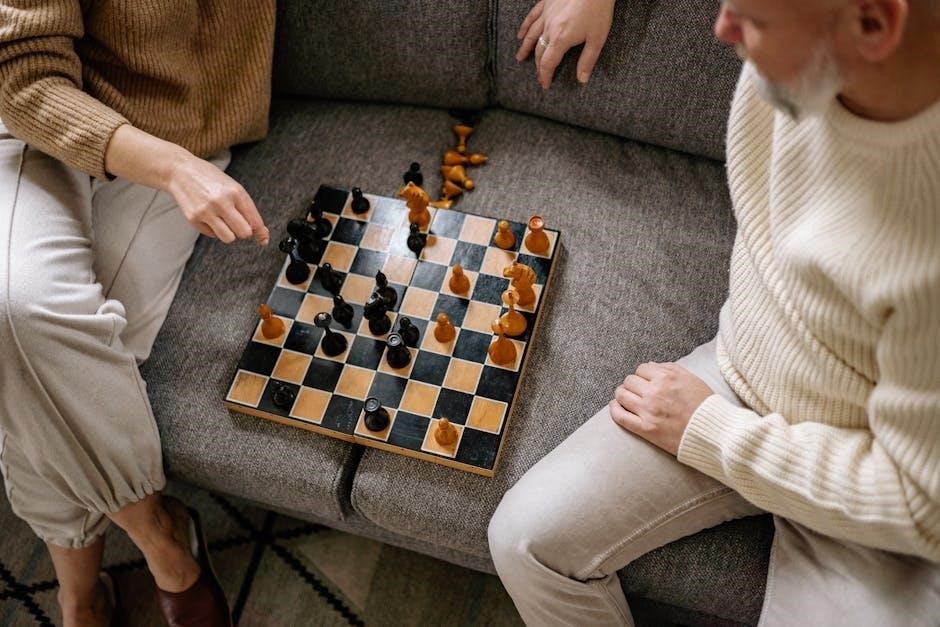Mastering chess strategy and tactics is essential for improving your game. Strategy involves long-term planning‚ while tactics focus on short-term goals. Understanding both is crucial for success.
1.1 Understanding the Basics of Chess Strategy
Chess strategy begins with understanding fundamental principles that guide decision-making. It involves controlling key areas of the board‚ such as the center‚ and developing pieces harmoniously. Long-term planning is crucial‚ as it sets the foundation for future moves. Key elements include pawn structure management‚ space advantage‚ and prophylactic thinking to prevent opponent threats. Strategy also involves adapting to the position’s dynamics‚ prioritizing objectives‚ and balancing offensive and defensive play. Mastery of these basics helps players create cohesive plans‚ leading to consistent improvement and success in games.
1.2 The Importance of Tactics in Chess
Tactics are the building blocks of chess success‚ focusing on short-term goals and immediate threats. They involve calculating sequences of moves to gain material or positional advantages. Mastering tactical motifs‚ such as pins‚ forks‚ and skewers‚ is vital for executing winning combinations. Tactics often decide the outcome of games‚ especially in sharp or complex positions. Regular practice and puzzle solving enhance tactical awareness‚ allowing players to spot opportunities and threats quickly. Strong tactical skills complement strategic plans‚ making them indispensable for players aiming to improve and dominate their games.
1.3 How Strategy and Tactics Work Together
Strategy and tactics are interconnected elements in chess‚ forming a cohesive plan to outmaneuver opponents. Strategy sets long-term goals‚ such as controlling the center or preparing for a decisive attack. Tactics‚ on the other hand‚ execute these plans through precise calculations and combinations. Together‚ they create a dynamic approach where strategic ideas guide tactical decisions‚ and tactical execution achieves strategic objectives. Players must balance both to adapt to changing positions‚ ensuring each move aligns with the overall game plan. This synergy is key to achieving victory and continuous improvement in chess.

Fundamental Principles of Chess Strategy
Mastering fundamental principles like control of the center‚ piece development‚ and pawn structure is vital. These concepts form the backbone of effective strategic play in chess.
2.1 Control of the Center
Control of the center is a cornerstone of chess strategy. The center squares are the most important on the board‚ as they provide the greatest mobility for pieces. By placing pawns and pieces in the center‚ you gain control over key lines and squares‚ making it easier to maneuver and attack. A strong center enhances your ability to launch effective attacks and defend against opponents’ threats. It also limits your opponent’s movement and creates weaknesses in their position. Neglecting the center can lead to strategic disadvantages‚ making it harder to coordinate pieces and control the game’s flow. Securing the center early is a fundamental principle of successful play.
2.2 Piece Development and Mobility
Effective piece development and mobility are vital for executing chess strategies. Moving pieces out from their starting positions quickly allows you to control the center and develop attacking or defensive plans. Each piece has unique abilities‚ and maximizing their mobility enhances your overall position. Knights‚ bishops‚ and queens should be developed to strong squares where they can influence the game. Rooks benefit from open lines‚ while the king should be safeguarded. Delaying development can lead to weaknesses‚ as your pieces remain passive and vulnerable to tactics. Prioritizing development ensures your pieces are active and ready to support strategic objectives‚ making your position more dynamic and formidable.
2.3 Pawn Structure and Management
Pawn structure is a critical aspect of chess strategy‚ as it determines the mobility and flexibility of your pieces. A well-managed pawn structure supports your pieces‚ controls key squares‚ and creates barriers against opponents. Weak pawns‚ such as isolated or doubled pawns‚ can become long-term liabilities. Conversely‚ pawn chains and passed pawns can be powerful weapons. Understanding how to build‚ maintain‚ and adapt your pawn structure is essential for executing strategic plans effectively. Proper pawn management often dictates the flow of the game and can make or break your overall strategy.
Essential Tactical Motifs

Tactical motifs like pins‚ forks‚ and skewers are key patterns in chess. They enable players to gain material or create decisive threats‚ forming the basis of tactical combinations.
3.1 Pins‚ Forks‚ and Skewers
Pins‚ forks‚ and skewers are fundamental tactical motifs in chess. A pin occurs when a piece is attacked‚ forcing it to stay or move‚ often exposing a more valuable piece behind. Forks involve attacking multiple pieces simultaneously‚ creating a dilemma for the opponent. Skewers are the reverse of pins‚ where a less valuable piece is attacked‚ forcing it to move and exposing a more valuable piece. These motifs are powerful tools for gaining material or positional advantages. Recognizing and executing them is crucial for improving tactical proficiency and outmaneuvering opponents effectively in any chess game.

3.2 Discovered Attacks and Double Attacks
A discovered attack occurs when a piece moves‚ uncovering a threat from another piece. This tactic forces the opponent to respond to the newly revealed threat‚ often leading to material gain. Double attacks involve targeting multiple enemy pieces simultaneously‚ creating a dilemma. For example‚ a fork attacks two pieces‚ forcing the opponent to choose which to save. These motifs are powerful tools for gaining material or positional advantages. Recognizing and executing discovered attacks and double attacks requires keen awareness of the board and the ability to calculate multiple moves ahead‚ making them essential for tactical mastery in chess.
3.4 Tactical Combinations in Practice
Tactical combinations are sequences of moves that exploit weaknesses in the opponent’s position. They often involve motifs like pins‚ forks‚ and skewers‚ which can lead to material gain or checkmate. In practice‚ recognizing these patterns requires sharp calculation and foresight. For example‚ a well-timed fork can force the opponent to lose a valuable piece. Training with puzzles and analyzing master games helps develop the skill to spot and execute these combinations effectively. By mastering tactical play‚ players can turn seemingly ordinary positions into decisive advantages‚ making it a cornerstone of chess success.
Strategic Concepts in Chess
Strategic concepts in chess involve long-term plans and ideas guiding the entire game. They include prophylactic thinking‚ positional play‚ and creating lasting threats. Mastering these enhances decision-making.
4.1 Positional Play vs. Tactical Play
Positional play focuses on controlling key areas of the board‚ improving piece placement‚ and creating long-term advantages. Tactical play emphasizes short-term gains through combinations and immediate threats. While positional play builds a strong foundation‚ tactical play often decides the outcome. A well-rounded player balances both‚ using positional strategies to set up tactical opportunities. Understanding when to prioritize one over the other is crucial for success in chess. This balance is a cornerstone of effective gameplay.
4.2 Prophylactic Thinking
Prophylactic thinking in chess involves anticipating and preventing your opponent’s plans before they materialize. It requires a deep understanding of the position and the ability to foresee potential threats. By identifying weaknesses in your opponent’s setup‚ you can take measures to neutralize their ideas. This approach often involves subtle moves‚ such as repositioning pieces or creating barriers‚ to limit their options. Prophylactic thinking is a hallmark of positional play and demonstrates a high level of strategic awareness. It allows players to control the game’s flow and create long-term advantages‚ making it a vital skill for success in chess.
4.3 Long-Term Planning
Long-term planning in chess involves setting strategic goals that guide your moves throughout the game; This requires evaluating the position‚ identifying key objectives‚ and creating a roadmap to achieve them. Effective long-term plans often focus on controlling key areas of the board‚ such as the center‚ or preparing for a decisive attack. Players must balance immediate tactics with overarching strategies‚ ensuring each move contributes to the larger plan. By maintaining a clear vision‚ you can navigate complexities and make informed decisions‚ ultimately leading to a stronger‚ more cohesive game.

Training and Resources
Enhance your chess skills with strategic resources like PDF guides‚ online courses‚ and master game analyses. These tools offer insights into tactics‚ strategies‚ and practical exercises for improvement.
5.1 Recommended PDFs for Learning Chess Strategy
Several PDF resources are highly recommended for mastering chess strategy. Titles like Common Chess Patterns and Improve Your Chess Tactics cater to both beginners and advanced players. These guides provide detailed insights into strategic concepts‚ such as pawn structures‚ piece development‚ and prophylactic thinking. Additionally‚ works like Steinitz’s Table of Elements offer deep dives into positional play and long-term planning. These PDFs are invaluable for players seeking to elevate their game by understanding the fundamentals and applying practical strategies effectively.
5.2 Exercises and Puzzles for Tactical Training
Tactical training is enhanced through targeted exercises and puzzles. These tools sharpen skills like pattern recognition and calculation. Puzzles often present positions requiring precise tactical shots‚ such as forks or skewers. Regular practice improves decision-making under time constraints; Advanced players benefit from complex combinations‚ while beginners focus on basic motifs. Many PDFs include curated puzzles‚ ensuring a structured learning path. Solving these exercises reinforces strategic concepts and accelerates progress. Consistent practice leads to improved performance in real games‚ making tactical puzzles an indispensable part of chess training.
5.3 Analyzing Master Games for Strategic Insights
Studying master games is a powerful way to gain strategic insights. By examining how top players handle various positions‚ you can learn key concepts like prophylactic thinking and long-term planning. Observing their decisions reveals how they balance tactical opportunities with positional play. Many PDF resources provide annotated games‚ highlighting critical moments and strategic motifs. Analyzing these games helps players understand how to apply theoretical knowledge in practical situations. This method bridges the gap between theory and practice‚ offering invaluable lessons for improving your own gameplay and strategic understanding.
